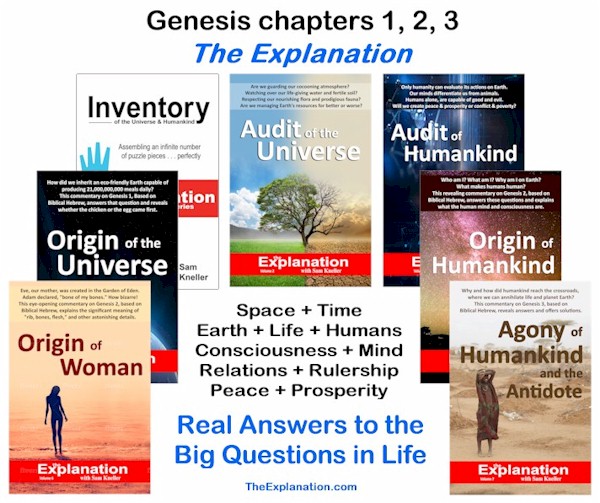We need an Inventory of the Universe because today, more than any other time in history, people can be in the know about the world around them—without understanding the intricate interconnections.

The four puzzle pieces in the outstretched hand are a picture perfect expression of what The Explanation is all about: Making a coherent whole out of all the disparate information we are inundated with.
An Inventory of the Universe is what we need. Surf the Internet, listen to the radio, watch TV, read the press, there’s more news available than ever before about what’s going on around the globe. Journalists and news stations strive to beat the competition by posting current events for your reading and viewing pleasure.
(Inventory of the Universe, Preface)
But isolated pieces of news will not give you a comprehensive understanding of the world at large. The knowledge that European governments have gone bankrupt, financial markets are down, third world nations are at war, and deflation has taken its grip does not reveal answers to fundamental questions such as “Why?” “What happened?” or “What went wrong?”
Yes, there are media programs that analyze the news. These are all too often complicated by pundits jabbering beyond our understanding and “experts” expressing contradicting viewpoints. Debating from different perspectives adds spice to the subject, but not always clarity. Even the vocabulary terms, and logic can muddle our minds and leave us more perplexed about what is really happening in our communities, nations, and the world.
A waiter in a hotel in Tunisia told me, “This generation today has computers and is richer than my father’s generation, but the older ones were happier and more content.” I think, in general, most of us would agree with this conclusion. What’s happened? What is going right? What is going wrong? Why?
Is there a relationship between political, economic, and social issues in Tunisia, Iceland, the United Kingdom, Nigeria, Thailand, Zimbabwe, Nicaragua, the United States, and other countries? Can someone please put history, philosophy, education, health, and literature into genuine perspective? Are current happenings merely a random series of unrelated, haphazard, isolated events—or do they fit into some sort of framework that can make sense and give us a plausible Explanation of what’s going on here on Earth?
Inventory of the Universe
This first book exposes the global situation from a worldly, purely rational point of view. I don’t purport to say that others have not reached these conclusions; indeed, they have. However, my intention is to lay out a logical framework of Explanation and systematize it so that you can follow the development of interlocking events and identify all the factors at play.
Some of this presentation could seem simplistic to certain readers. The idea is to make the information presented herein accessible to all. Inventory of the Universe is intended to be neither prose nor poetry, but everyday ideas offered in understandable language that is easy to read. Let’s systematically go from point A to point B for anyone, no matter what his or her level of knowledge, reading skill, or literary prowess—or lack thereof—may be.
Inventory of the Universe includes enough material (along with the references to information available in other written works and on the Internet) to guide even the novice reader to a clearer understanding of how the world ticks. On the other hand, there are a few chapters—particularly those dealing with the Big Bang, space, elementary particles, life, DNA, and the human brain—that could be complex simply because those subjects are more intricate and involved.
Overall Comprehension of the Universe
These chapters are necessary for readers to grasp the overall picture. They might be somewhat advanced scientifically since you’ll learn what scientists have found, but you’ll always be able to skim that material, or reread it several times, to enhance comprehension.
I’ve added a few diagrams to assist with the visual digestion of this knowledge as well. We need to recognize that the world and the universe combine to form a big machine and that those of us on Earth are little cogs—important cogs, but small nonetheless in this vast arena of observation and discovery of our natural and physical surroundings and the events that occur within them.
Today we are fed news piecemeal, generally getting a lopsided point of view and certainly not a global one. This author has also been influenced by his culture, education, upbringing, heredity, and environment. For this reason, the views presented in this Inventory of the Universe cannot be totally unbiased.
A Global Explanation of the Universe
You might not agree with various viewpoints. Furthermore, as we progress, I will take stances on certain issues. I’ll give you my plausible Explanation for adopting each position and continue on from there. Hopefully, in spite of any discord, you’ll continue reading simply to see if there is a global Explanation that makes sense of the world as we know it. You just might pick up a few interesting ideas that open you up to some concepts you may not have contemplated.
No solid, global Explanation has been given as to why and how we are at this juncture in history. How can poverty and progress advance in tandem? Both of these rival tendencies impact our everyday lives. They do this not only in the financial sense but also socially (via family breakdowns), ethnically, educationally, physically, psychologically, and in numerous other ways. Yet I wouldn’t want to live at any other epoch in history.
These are exciting, invigorating, unprecedented times. So let’s take a front-row seat and see how life unfolds. Where to start? If we’re going to talk about why the world—and particularly its inhabitants—are in their present state and discuss whether this situation needs any modification, let’s first establish the basis for our discussion. For example:
Suppose you have a thousand-piece jigsaw puzzle in front of you, with no picture to reveal what the puzzle actually represents. To assemble it, you’ll need a systematic method.
Here’s one approach:
- Turn all the pieces face up and find the pieces with a straight edge. Those comprise the frame, which you can then assemble.
- Pieces could then be separated by color, after which some objects might come into focus and you may be able to put a few pieces together.
- It’ll be “try and try again” until, little by little, the puzzle will come together and you’ll finally see the whole picture.
Inventory represents that puzzle and follows that method
We’re going to turn over all the pieces, which represent the inanimate world (space, Earth’s atmosphere, water, land) as well as the animate world (flora, fauna, man), including man’s aptitudes, institutions, and knowledge. I’ll paint a clear picture of each piece. In book two, I’ll do an Audit of all the pieces. Starting with book three, I’ll put all the pieces of the jigsaw in place–that’s the Inventory of the Universe–and you’ll have the big picture or The Explanation.
However, I do want to caution you and make a very strong suggestion: do not read the last chapters first or read any chapters out of order. It would be like taking any one of those jigsaw pieces and using it to extrapolate the entire image. It can’t be done. If you do it, I guarantee you will not understand how I arrive at the final full image. It’s very probable that you will throw the books down in bewilderment! I request that you continue making progress just as you would in putting the jigsaw puzzle together.
I highly recommend that you let other people put the jigsaw puzzle together for themselves. Lend them this and the following books, but don’t try to make a shortcut in the story.
The puzzle comes together piece by piece, and the more pieces you have in their correct places, the easier it becomes to see where the others fit.
Each piece must occupy its one and only place in the puzzle.
We can’t force it into a location where it doesn’t belong, or we’ll be in trouble. That’s what all the worldly debates are about: how each person feels his or her viewpoints, perspectives, or positions are the right ones.
If you follow many of these, you’re soon lost in a maze of pieces that don’t reveal a clear picture.
If you find yourself asking “why” as you contemplate the world scene today, you’ve come to the right book–Inventory of the Universe.
Let’s put the jigsaw puzzle together piece by piece.
This blog post is an excerpt from the Preface of the book Inventory of the Universe
Dig Deeper into The Explanation
Online Study Courses to Uncover the Mystery of Adam and Eve’s Nakedness… with no fuss. Free video mini-course revealing the God-intended meaning of Scripture via Biblical Hebrew. It’s so easy, it’ll blow you away. Join now and add new motivation to your Bible study.
Join The Explanation Newsletter to stay informed of updates. and future events. No obligations, total privacy, unsubscribe anytime, if you want.
The Explanation series of seven books. Free to read online or purchase these valuable commentaries on Genesis 1-3 from your favorite book outlet. E-book and paperback formats are available. Use this link to see the details of each book and buy from your favorite store.

Since you read all the way to here… you liked it. Please use the Social Network links just below to share this information from The Explanation, Inventory of the Universe – Preface to an Explosive Book



Let’s Connect!